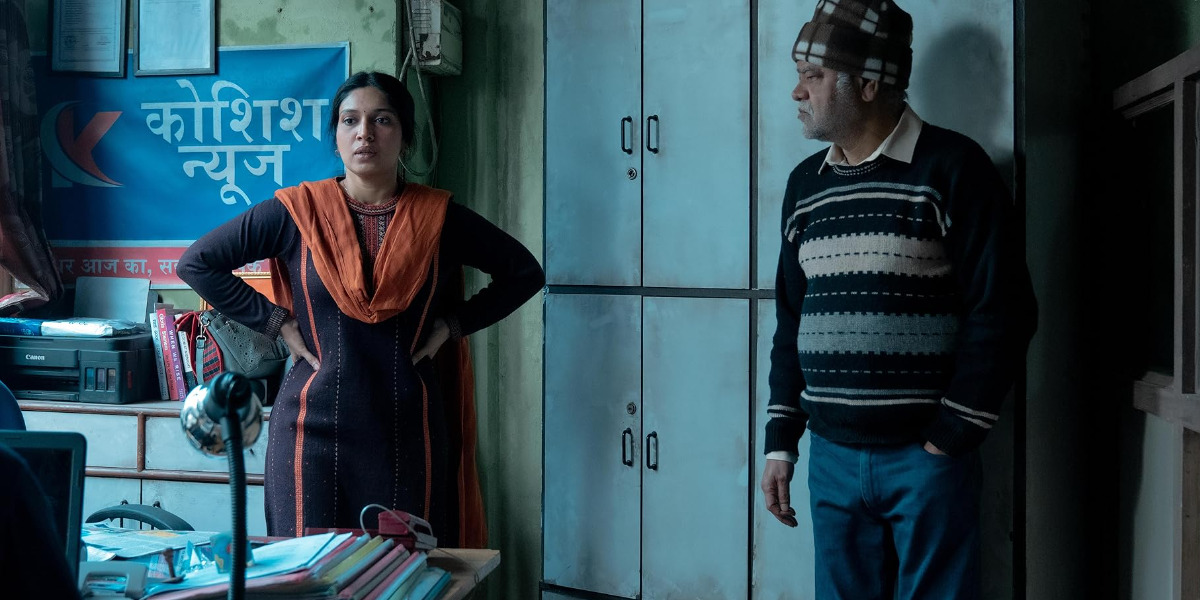‘Bhakshak,’ the Hindi Netflix crime-drama film, revolves around a small-town TV reporter’s insistent pursuit of justice for young female victims of sexual abuse at a State Children’s Welfare Home. The protagonist, Vaishali Singh, helms her own independent news channel that garners scant few viewers with the sole help of her cameraman, Bhaskar Sinha. However, after the woman comes across an unneglectable report detailing the blatant abuse of several young girls at Bansi Sahu’s Balika Seva Grih, Vaishali finds herself putting her own life at risk to bring the story to authorities attention and deliver Sahu to justice.
In charting an emotionally charged narrative with sensitive topics at the center, filmmaker Pulkit delivers a heartfelt tale about injustice as it unfolds in a society that attempts to turn a blind eye to others’ sufferings. Thus, as the viewers witness the disheartening yet hopeful tale unravel, the socially prevalent subject matter compels them to wonder about the film’s connection to real-life events.
Bhakshak Has Parallels with Muzaffarpur Shelter Home Rape Case
‘Bhakshak’ is only partially inspired by a true story. The film is deeply rooted in reality while still maintaining enough distance from it to chart an independent path in its narrative without the caveat of depicting select instances with real-life accuracy. Consequently, the film’s screenplay, penned by filmmaker Pulkit and his co-writer Jyotsana Nath, remains a non-biographical story significantly inspired by real life.

While lead Actress Bhumi Pednekar describes the film as a fictional story inspired by a number of true events, one particular real-life story presents considerable similarities to ‘Bhakshak,’ namely the Muzaffarpur Shelter Home Rape case. The real-life criminal account found its beginning in 2018 when Mohammed Tarique and a group of Tata Institute of Social Sciences researchers took the initiative to survey Bihar State’s private shelter homes after securing permission from Atul Prasad.
To the group’s horror, numerous shelter homes showcased complaints about sexual violence and harassment, with Muzaffarpur shelter home, under Brajesh Thakur’s control, coming up as a prime concern. According to sources, the state government received the TISS reports—which were finished in February 2018— by April. A month later, Thakur saw an FIR filed against him. Reports by The Indian Express suggest that the momentary lapse in the process was a result of the government’s subsequent embarrassment.
The film expands upon this through Pednekar’s protagonist character, Vaishali Singh, the journalist who fails to have a basis in reality in relation to the Muzaffarpur Shelter Home case. Her character reflects a crucial aspect of real life by highlighting the importance of journalism in any country’s justice system. Furthermore, her storyline compels the audience to take responsibility as ignorant bystanders to society’s various crimes.
In The Muzaffarpur Shelter Home case, the government moved the girls residing at the shelter to other protective alternatives on May 29, 2018, and lodged the FIR against Thakur and the other accused two days later. The victims shared their horror stories, narrating instances of torture and sexual abuse before a court of law, compelling the State’s Chief Minister to shift the case into the hands of the CBI. Reportedly, the girls who fell victim to Thakur and the others’ abuse ranged in age from 12 to 20, with allegations of even younger children facing abuse.
Although victims also made allegations of murder against the establishment and its owners, the CBI never found any incriminating evidence to prove the same. Ultimately, of the 20 people arrested for the crime, one was acquitted, while the other 19 saw charges of criminal conspiracy to commit rape and sexual assault. Thakur, named the prime accused of the crimes, received a lifetime prison sentence.
The reports that continued to come out of the Muzaffarpur Shelter Home case hold many points of similarities to ‘Bhakshak’ and its exploration of a kindred situation. For instance, victims reported the usage of sleeping pills and drugs to subjugate them before assault. Furthermore, there were allegations of Thakur forcing the girls in the Shelter to kill another disabled girl. As a result, while the film strives to reflect a very specific facet of reality in relation to human trafficking, its connection to Thakur and his crimes remains evident.
Yet, since the film holds many significant departures from the real-life instance, it’s important to remember its non-biographical nature. The film harvests inspiration from the general bleak reality of the sensitive, socially-relevant subject matter of human trafficking. Ultimately, ‘Bhakshak’ mines its inspiration from real life and crafts its narrative.
Read More: Is Bansi Sahu Based on a Real Criminal? Is Balika Seva Grih a Real Girl’s Shelter Home?


You must be logged in to post a comment.